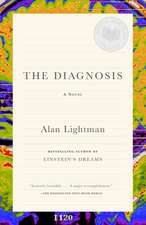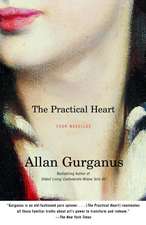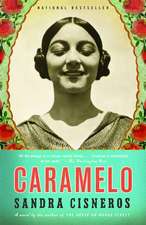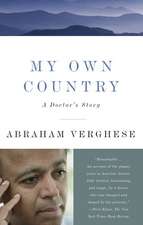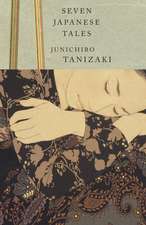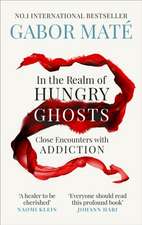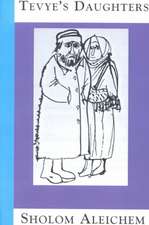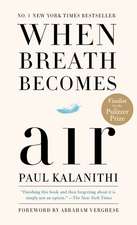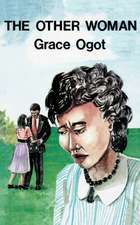Cutting For Stone
Autor Abraham Vergheseen Limba Engleză Paperback – 26 dec 2009
| Toate formatele și edițiile | Preț | Express |
|---|---|---|
| Paperback (2) | 61.10 lei 3-5 săpt. | +20.34 lei 6-12 zile |
| Vintage Publishing – 31 dec 2009 | 61.10 lei 3-5 săpt. | +20.34 lei 6-12 zile |
| Vintage Publishing – 26 dec 2009 | 61.62 lei 21-33 zile | +26.29 lei 6-12 zile |
Preț: 61.62 lei
Preț vechi: 71.59 lei
-14% Nou
Puncte Express: 92
Preț estimativ în valută:
11.79€ • 12.31$ • 9.76£
11.79€ • 12.31$ • 9.76£
Carte disponibilă
Livrare economică 14-26 martie
Livrare express 27 februarie-05 martie pentru 36.28 lei
Preluare comenzi: 021 569.72.76
Specificații
ISBN-13: 9780099443636
ISBN-10: 0099443635
Pagini: 560
Dimensiuni: 128 x 202 x 40 mm
Greutate: 0.4 kg
Editura: Vintage Publishing
Locul publicării:United Kingdom
ISBN-10: 0099443635
Pagini: 560
Dimensiuni: 128 x 202 x 40 mm
Greutate: 0.4 kg
Editura: Vintage Publishing
Locul publicării:United Kingdom
Notă biografică
Abraham Verghese is Professor and Senior Associate Chair for the Theory and Practice of Medicine at the Stanford University School of Medicine. He was the founding director of the Center for Medical Humanities & Ethics at the University of Texas Health Science Center, San Antonio, where he is now an adjunct professor. He is the author of My Own Country, a 1994 NBCC Finalist and a Time Best Book of the Year, and The Tennis Partner, a New York Times Notable Book. A graduate of the Iowa Writers’ Workshop, he has published essays and short stories that have appeared in The New Yorker, The New York Times, The Atlantic Monthly, Esquire, Granta, The Wall Street Journal, and elsewhere. He lives in Palo Alto, California.
Extras
The Coming
After eight months spent in the obscurity of our mother’s womb, my brother, Shiva, and I came into the world in the late afternoon of the twentieth of September in the year of grace 1954. We took our first breaths at an elevation of eight thousand feet in the thin air of Addis Ababa, capital city of Ethiopia. The miracle of our birth took place in Missing Hospital’s Operating Theater 3, the very room where our mother, Sister Mary Joseph Praise, spent most of her working hours, and in which she had been most fulfilled.
When our mother, a nun of the Diocesan Carmelite Order of Madras, unexpectedly went into labor that September morning, the big rain in Ethiopia had ended, its rattle on the corrugated tin roofs of Missing ceasing abruptly like a chatterbox cut off in midsentence. Over night, in that hushed silence, the meskel flowers bloomed, turning the hillsides of Addis Ababa into gold. In the meadows around Missing the sedge won its battle over mud, and a brilliant carpet now swept right up to the paved threshold of the hospital, holding forth the promise of something more substantial than cricket, croquet, or shuttlecock.
Missing sat on a verdant rise, the irregular cluster of whitewashed one- and two-story buildings looking as if they were pushed up from the ground in the same geologic rumble that created the Entoto Mountains. Troughlike flower beds, fed by the runoff from the roof gutters, surrounded the squat buildings like a moat. Matron Hirst’s roses overtook the walls, the crimson blooms framing every window and reaching to the roof. So fertile was that loamy soil that Matron—Missing Hospital’s wise and sensible leader—cautioned us against stepping into it barefoot lest we sprout new toes.
Five trails flanked by shoulder-high bushes ran away from the main hospital buildings like spokes of a wheel, leading to five thatched-roof bungalows that were all but hidden by copse, by hedgerows, by wild eucalyptus and pine. It was Matron’s intent that Missing resemble an arboretum, or a corner of Kensington Gardens (where, before she came to Africa, she used to walk as a young nun), or Eden before the Fall.
Missing was really Mission Hospital, a word that on the Ethiopian tongue came out with a hiss so it sounded like “Missing.” A clerk in the Ministry of Health who was a fresh high-school graduate had typed out the missing hospital on the license, a phonetically correct spelling as far as he was concerned. A reporter for the Ethiopian Herald perpetuated this misspelling. When Matron Hirst had approached the clerk in the ministry to correct this, he pulled out his original typescript. “See for yourself, madam. Quod erat demonstrandum it is Missing,” he said, as if he’d proved Pythagoras’s theorem, the sun’s central position in the solar system, the roundness of the earth, and Missing’s precise location at its imagined corner. And so Missing it was.
Not a cry or a groan escaped from Sister Mary Joseph Praise while in the throes of her cataclysmic labor. But just beyond the swinging door in the room adjoining Operating Theater 3, the oversize autoclave (donated by the Lutheran church in Zurich) bellowed and wept for my mother while its scalding steam sterilized the surgical instruments and towels that would be used on her. After all, it was in the corner of the autoclave room, right next to that stainless-steel behemoth, that my mother kept a sanctuary for herself during the seven years she spent at Missing before our rude arrival. Her one-piece desk-and-chair, rescued from a defunct mission school, and bearing the gouged frustration of many a pupil, faced the wall. Her white cardigan, which I am told she often slipped over her shoulders when she was between operations, lay over the back of the chair.
On the plaster above the desk my mother had tacked up a calendar print of Bernini’s famous sculpture of St. Teresa of Avila. The figure of St. Teresa lies limp, as if in a faint, her lips parted in ecstasy, her eyes unfocused, lids half closed. On either side of her, a voyeuristic chorus peers down from the prie-dieux. With a faint smile and a body more muscular than befits his youthful face, a boy angel stands over the saintly, voluptuous sister. The fingertips of his left hand lift the edge of the cloth covering her bosom. In his right hand he holds an arrow as delicately as a violinist holds a bow.
Why this picture? Why St. Teresa, Mother?
As a little boy of four, I took myself away to this windowless room to study the image. Courage alone could not get me past that heavy door, but my sense that she was there, my obsession to know the nun who was my mother, gave me strength. I sat next to the autoclave which rumbled and hissed like a waking dragon, as if the hammering of my heart had roused the beast. Gradually, as I sat at my mother’s desk, a peace would come over me, a sense of communion with her.
I learned later that no one had dared remove her cardigan from where it sat draped on the chair. It was a sacred object. But for a four-yearold, everything is sacred and ordinary. I pulled that Cuticura-scented garment around my shoulders. I rimmed the dried-out inkpot with my nail, tracing a path her fingers had taken. Gazing up at the calendar print just as she must have while sitting there in that windowless room, I was transfixed by that image. Years later, I learned that St. Teresa’s recurrent vision of the angel was called the transverberation, which the dictionary said was the soul “inflamed” by the love of God, and the heart “pierced” by divine love; the metaphors of her faith were also the metaphors of medicine. At four years of age, I didn’t need words like “transverberation” to feel reverence for that image. Without photographs of her to go by, I couldn’t help but imagine that the woman in the picture was my mother, threatened and about to be ravished by the spear-wielding boy-angel. “When are you coming, Mama?” I would ask, my small voice echoing off the cold tile. When are you coming?
I would whisper my answer: “By God!” That was all I had to go by: Dr. Ghosh’s declaration the time I’d first wandered in there and he’d come looking for me and had stared at the picture of St. Teresa over my shoulders; he lifted me in his strong arms and said in that voice of his that was every bit a match for the autoclave: “She is CUM-MING, by God!”
Forty-six and four years have passed since my birth, and miraculously I have the opportunity to return to that room. I find I am too large for that chair now, and the cardigan sits atop my shoulders like the lace amice of a priest. But chair, cardigan, and calendar print of transverberation are still there. I, Marion Stone, have changed, but little else has. Being in that unaltered room propels a thumbing back through time and memory. The unfading print of Bernini’s statue of St. Teresa (now framed and under glass to preserve what my mother tacked up) seems to demand this. I am forced to render some order to the events of my life, to say it began here, and then because of this, that happened, and this is how the end connects to the beginning, and so here I am.
We come unbidden into this life, and if we are lucky we find a purpose beyond starvation, misery, and early death which, lest we forget, is the common lot. I grew up and I found my purpose and it was to become a physician. My intent wasn’t to save the world as much as to heal myself.
Few doctors will admit this, certainly not young ones, but subconsciously, in entering the profession, we must believe that ministering to others will heal our woundedness. And it can. But it can also deepen the wound.
I chose the specialty of surgery because of Matron, that steady presence during my boyhood and adolescence. “What is the hardest thing you can possibly do?” she said when I went to her for advice on the darkest day of the first half of my life. I squirmed. How easily Matron probed the gap between ambition and expediency. “Why must I do what is hardest?”
“Because, Marion, you are an instrument of God. Don’t leave the instrument sitting in its case, my son. Play! Leave no part of your instrument unexplored. Why settle for ‘Three Blind Mice’ when you can play the ‘Gloria’?”
How unfair of Matron to evoke that soaring chorale which always made me feel that I stood with every mortal creature looking up to the heavens in dumb wonder. She understood my unformed character.
“But, Matron, I can’t dream of playing Bach, the ‘Gloria’ . . . ,” I said under my breath. I’d never played a string or wind instrument. I couldn’t read music.
“No, Marion,” she said, her gaze soft, reaching for me, her gnarled hands rough on my cheeks. “No, not Bach’s ‘Gloria.’ Yours! Your ‘Gloria’ lives within you. The greatest sin is not finding it, ignoring what God made possible in you.”
I was temperamentally better suited to a cognitive discipline, to an introspective field—internal medicine, or perhaps psychiatry. The sight of the operating theater made me sweat. The idea of holding a scalpel caused coils to form in my belly. (It still does.) Surgery was the most difficult thing I could imagine.
And so I became a surgeon.
Thirty years later, I am not known for speed, or daring, or technical genius. Call me steady, call me plodding; say I adopt the style and technique that suits the patient and the particular situation and I’ll consider that high praise. I take heart from my fellow physicians who come to me when they themselves must suffer the knife. They know that Marion Stone will be as involved after the surgery as before and during. They know I have no use for surgical aphorisms such as “When in doubt, cut it out” or “Why wait when you can operate” other than for how reliably they reveal the shallowest intellects in our field. My father, for whose skills as a surgeon I have the deepest respect, says, “The operation with the best outcome is the one you decide not to do.” Knowing when not to operate, knowing when I am in over my head, knowing when to call for the assistance of a surgeon of my father’s caliber—that kind of talent, that kind of “brilliance,” goes unheralded.
On one occasion with a patient in grave peril, I begged my father to operate. He stood silent at the bedside, his fingers lingering on the patient’s pulse long after he had registered the heart rate, as if he needed the touch of skin, the thready signal in the radial artery to catalyze his decision. In his taut expression I saw complete concentration. I imagined I could see the cogs turning in his head; I imagined I saw the shimmer of tears in his eyes. With utmost care he weighed one option against another. At last, he shook his head, and turned away.
I followed. “Dr. Stone,” I said, using his title though I longed to cry out, Father! “An operation is his only chance,” I said. In my heart I knew the chance was infinitesimally small, and the first whiff of anesthesia might end it all. My father put his hand on my shoulder. He spoke to me gently, as if to a junior colleague rather than his son. “Marion, remember the Eleventh Commandment,” he said. “Thou shall not operate on the day of a patient’s death.”
I remember his words on full-moon nights in Addis Ababa when knives are flashing and rocks and bullets are flying, and when I feel as if I am standing in an abattoir and not in Operating Theater 3, my skin flecked with the grist and blood of strangers. I remember. But you don’t always know the answers before you operate. One operates in the now. Later, the retrospectoscope, that handy tool of the wags and pundits, the conveners of the farce we call M&M—morbidity and mortality conference—will pronounce your decision right or wrong. Life, too, is like that. You live it forward, but understand it backward. It is only when you stop and look to the rear that you see the corpse caught under your wheel.
Now, in my fiftieth year, I venerate the sight of the abdomen or chest laid open. I’m ashamed of our human capacity to hurt and maim one another, to desecrate the body. Yet it allows me to see the cabalistic harmony of heart peeking out behind lung, of liver and spleen consulting each other under the dome of the diaphragm—these things leave me speechless. My fingers “run the bowel” looking for holes that a blade or bullet might have created, coil after glistening coil, twenty-three feet of it compacted into such a small space. The gut that has slithered past my fingers like this in the African night would by now reach the Cape of Good Hope, and I have yet to see the serpent’s head. But I do see the ordinary miracles under skin and rib and muscle, visions concealed from their owner. Is there a greater privilege on earth?
At such moments I remember to thank my twin brother, Shiva—Dr. Shiva Praise Stone—to seek him out, to find his reflection in the glass panel that separates the two operating theaters, and to nod my thanks because he allows me to be what I am today. A surgeon. According to Shiva, life is in the end about fixing holes. Shiva didn’t speak in metaphors. Fixing holes is precisely what he did. Still, it’s an apt metaphor for our profession. But there’s another kind of hole, and that is the wound that divides family. Sometimes this wound occurs at the moment of birth, sometimes it happens later. We are all fixing what is broken. It is the task of a lifetime. We’ll leave much unfinished for the next generation.
Born in Africa, living in exile in America, then returning at last to Africa, I am proof that geography is destiny. Destiny has brought me back to the precise coordinates of my birth, to the very same operating theater where I was born. My gloved hands share the space above the table in Operating Theater 3 that my mother and father’s hands once occupied.
Some nights the crickets cry zaa-zee, zaa-zee, thousands of them drowning out the coughs and grunts of the hyenas in the hillsides. Suddenly, nature turns quiet. It is as if roll call is over and it is time now in the darkness to find your mate and retreat. In the ensuing vacuum of silence, I hear the high-pitched humming of the stars and I feel exultant, thankful for my insignificant place in the galaxy. It is at such times that I feel my indebtedness to Shiva.
Twin brothers, we slept in the same bed till our teens, our heads touching, our legs and torsos angled away. We outgrew that intimacy, but I still long for it, for the proximity of his skull. When I wake to the gift of yet another sunrise, my first thought is to rouse him and say, I owe you the sight of morning.
What I owe Shiva most is this: to tell the story. It is one my mother, Sister Mary Joseph Praise, did not reveal and my fearless father, Thomas Stone, ran from, and which I had to piece together. Only the telling can heal the rift that separates my brother and me. Yes, I have infinite faith in the craft of surgery, but no surgeon can heal the kind of wound that divides two brothers. Where silk and steel fail, story must succeed. To begin at the beginning . . .
From the Hardcover edition.
After eight months spent in the obscurity of our mother’s womb, my brother, Shiva, and I came into the world in the late afternoon of the twentieth of September in the year of grace 1954. We took our first breaths at an elevation of eight thousand feet in the thin air of Addis Ababa, capital city of Ethiopia. The miracle of our birth took place in Missing Hospital’s Operating Theater 3, the very room where our mother, Sister Mary Joseph Praise, spent most of her working hours, and in which she had been most fulfilled.
When our mother, a nun of the Diocesan Carmelite Order of Madras, unexpectedly went into labor that September morning, the big rain in Ethiopia had ended, its rattle on the corrugated tin roofs of Missing ceasing abruptly like a chatterbox cut off in midsentence. Over night, in that hushed silence, the meskel flowers bloomed, turning the hillsides of Addis Ababa into gold. In the meadows around Missing the sedge won its battle over mud, and a brilliant carpet now swept right up to the paved threshold of the hospital, holding forth the promise of something more substantial than cricket, croquet, or shuttlecock.
Missing sat on a verdant rise, the irregular cluster of whitewashed one- and two-story buildings looking as if they were pushed up from the ground in the same geologic rumble that created the Entoto Mountains. Troughlike flower beds, fed by the runoff from the roof gutters, surrounded the squat buildings like a moat. Matron Hirst’s roses overtook the walls, the crimson blooms framing every window and reaching to the roof. So fertile was that loamy soil that Matron—Missing Hospital’s wise and sensible leader—cautioned us against stepping into it barefoot lest we sprout new toes.
Five trails flanked by shoulder-high bushes ran away from the main hospital buildings like spokes of a wheel, leading to five thatched-roof bungalows that were all but hidden by copse, by hedgerows, by wild eucalyptus and pine. It was Matron’s intent that Missing resemble an arboretum, or a corner of Kensington Gardens (where, before she came to Africa, she used to walk as a young nun), or Eden before the Fall.
Missing was really Mission Hospital, a word that on the Ethiopian tongue came out with a hiss so it sounded like “Missing.” A clerk in the Ministry of Health who was a fresh high-school graduate had typed out the missing hospital on the license, a phonetically correct spelling as far as he was concerned. A reporter for the Ethiopian Herald perpetuated this misspelling. When Matron Hirst had approached the clerk in the ministry to correct this, he pulled out his original typescript. “See for yourself, madam. Quod erat demonstrandum it is Missing,” he said, as if he’d proved Pythagoras’s theorem, the sun’s central position in the solar system, the roundness of the earth, and Missing’s precise location at its imagined corner. And so Missing it was.
Not a cry or a groan escaped from Sister Mary Joseph Praise while in the throes of her cataclysmic labor. But just beyond the swinging door in the room adjoining Operating Theater 3, the oversize autoclave (donated by the Lutheran church in Zurich) bellowed and wept for my mother while its scalding steam sterilized the surgical instruments and towels that would be used on her. After all, it was in the corner of the autoclave room, right next to that stainless-steel behemoth, that my mother kept a sanctuary for herself during the seven years she spent at Missing before our rude arrival. Her one-piece desk-and-chair, rescued from a defunct mission school, and bearing the gouged frustration of many a pupil, faced the wall. Her white cardigan, which I am told she often slipped over her shoulders when she was between operations, lay over the back of the chair.
On the plaster above the desk my mother had tacked up a calendar print of Bernini’s famous sculpture of St. Teresa of Avila. The figure of St. Teresa lies limp, as if in a faint, her lips parted in ecstasy, her eyes unfocused, lids half closed. On either side of her, a voyeuristic chorus peers down from the prie-dieux. With a faint smile and a body more muscular than befits his youthful face, a boy angel stands over the saintly, voluptuous sister. The fingertips of his left hand lift the edge of the cloth covering her bosom. In his right hand he holds an arrow as delicately as a violinist holds a bow.
Why this picture? Why St. Teresa, Mother?
As a little boy of four, I took myself away to this windowless room to study the image. Courage alone could not get me past that heavy door, but my sense that she was there, my obsession to know the nun who was my mother, gave me strength. I sat next to the autoclave which rumbled and hissed like a waking dragon, as if the hammering of my heart had roused the beast. Gradually, as I sat at my mother’s desk, a peace would come over me, a sense of communion with her.
I learned later that no one had dared remove her cardigan from where it sat draped on the chair. It was a sacred object. But for a four-yearold, everything is sacred and ordinary. I pulled that Cuticura-scented garment around my shoulders. I rimmed the dried-out inkpot with my nail, tracing a path her fingers had taken. Gazing up at the calendar print just as she must have while sitting there in that windowless room, I was transfixed by that image. Years later, I learned that St. Teresa’s recurrent vision of the angel was called the transverberation, which the dictionary said was the soul “inflamed” by the love of God, and the heart “pierced” by divine love; the metaphors of her faith were also the metaphors of medicine. At four years of age, I didn’t need words like “transverberation” to feel reverence for that image. Without photographs of her to go by, I couldn’t help but imagine that the woman in the picture was my mother, threatened and about to be ravished by the spear-wielding boy-angel. “When are you coming, Mama?” I would ask, my small voice echoing off the cold tile. When are you coming?
I would whisper my answer: “By God!” That was all I had to go by: Dr. Ghosh’s declaration the time I’d first wandered in there and he’d come looking for me and had stared at the picture of St. Teresa over my shoulders; he lifted me in his strong arms and said in that voice of his that was every bit a match for the autoclave: “She is CUM-MING, by God!”
Forty-six and four years have passed since my birth, and miraculously I have the opportunity to return to that room. I find I am too large for that chair now, and the cardigan sits atop my shoulders like the lace amice of a priest. But chair, cardigan, and calendar print of transverberation are still there. I, Marion Stone, have changed, but little else has. Being in that unaltered room propels a thumbing back through time and memory. The unfading print of Bernini’s statue of St. Teresa (now framed and under glass to preserve what my mother tacked up) seems to demand this. I am forced to render some order to the events of my life, to say it began here, and then because of this, that happened, and this is how the end connects to the beginning, and so here I am.
We come unbidden into this life, and if we are lucky we find a purpose beyond starvation, misery, and early death which, lest we forget, is the common lot. I grew up and I found my purpose and it was to become a physician. My intent wasn’t to save the world as much as to heal myself.
Few doctors will admit this, certainly not young ones, but subconsciously, in entering the profession, we must believe that ministering to others will heal our woundedness. And it can. But it can also deepen the wound.
I chose the specialty of surgery because of Matron, that steady presence during my boyhood and adolescence. “What is the hardest thing you can possibly do?” she said when I went to her for advice on the darkest day of the first half of my life. I squirmed. How easily Matron probed the gap between ambition and expediency. “Why must I do what is hardest?”
“Because, Marion, you are an instrument of God. Don’t leave the instrument sitting in its case, my son. Play! Leave no part of your instrument unexplored. Why settle for ‘Three Blind Mice’ when you can play the ‘Gloria’?”
How unfair of Matron to evoke that soaring chorale which always made me feel that I stood with every mortal creature looking up to the heavens in dumb wonder. She understood my unformed character.
“But, Matron, I can’t dream of playing Bach, the ‘Gloria’ . . . ,” I said under my breath. I’d never played a string or wind instrument. I couldn’t read music.
“No, Marion,” she said, her gaze soft, reaching for me, her gnarled hands rough on my cheeks. “No, not Bach’s ‘Gloria.’ Yours! Your ‘Gloria’ lives within you. The greatest sin is not finding it, ignoring what God made possible in you.”
I was temperamentally better suited to a cognitive discipline, to an introspective field—internal medicine, or perhaps psychiatry. The sight of the operating theater made me sweat. The idea of holding a scalpel caused coils to form in my belly. (It still does.) Surgery was the most difficult thing I could imagine.
And so I became a surgeon.
Thirty years later, I am not known for speed, or daring, or technical genius. Call me steady, call me plodding; say I adopt the style and technique that suits the patient and the particular situation and I’ll consider that high praise. I take heart from my fellow physicians who come to me when they themselves must suffer the knife. They know that Marion Stone will be as involved after the surgery as before and during. They know I have no use for surgical aphorisms such as “When in doubt, cut it out” or “Why wait when you can operate” other than for how reliably they reveal the shallowest intellects in our field. My father, for whose skills as a surgeon I have the deepest respect, says, “The operation with the best outcome is the one you decide not to do.” Knowing when not to operate, knowing when I am in over my head, knowing when to call for the assistance of a surgeon of my father’s caliber—that kind of talent, that kind of “brilliance,” goes unheralded.
On one occasion with a patient in grave peril, I begged my father to operate. He stood silent at the bedside, his fingers lingering on the patient’s pulse long after he had registered the heart rate, as if he needed the touch of skin, the thready signal in the radial artery to catalyze his decision. In his taut expression I saw complete concentration. I imagined I could see the cogs turning in his head; I imagined I saw the shimmer of tears in his eyes. With utmost care he weighed one option against another. At last, he shook his head, and turned away.
I followed. “Dr. Stone,” I said, using his title though I longed to cry out, Father! “An operation is his only chance,” I said. In my heart I knew the chance was infinitesimally small, and the first whiff of anesthesia might end it all. My father put his hand on my shoulder. He spoke to me gently, as if to a junior colleague rather than his son. “Marion, remember the Eleventh Commandment,” he said. “Thou shall not operate on the day of a patient’s death.”
I remember his words on full-moon nights in Addis Ababa when knives are flashing and rocks and bullets are flying, and when I feel as if I am standing in an abattoir and not in Operating Theater 3, my skin flecked with the grist and blood of strangers. I remember. But you don’t always know the answers before you operate. One operates in the now. Later, the retrospectoscope, that handy tool of the wags and pundits, the conveners of the farce we call M&M—morbidity and mortality conference—will pronounce your decision right or wrong. Life, too, is like that. You live it forward, but understand it backward. It is only when you stop and look to the rear that you see the corpse caught under your wheel.
Now, in my fiftieth year, I venerate the sight of the abdomen or chest laid open. I’m ashamed of our human capacity to hurt and maim one another, to desecrate the body. Yet it allows me to see the cabalistic harmony of heart peeking out behind lung, of liver and spleen consulting each other under the dome of the diaphragm—these things leave me speechless. My fingers “run the bowel” looking for holes that a blade or bullet might have created, coil after glistening coil, twenty-three feet of it compacted into such a small space. The gut that has slithered past my fingers like this in the African night would by now reach the Cape of Good Hope, and I have yet to see the serpent’s head. But I do see the ordinary miracles under skin and rib and muscle, visions concealed from their owner. Is there a greater privilege on earth?
At such moments I remember to thank my twin brother, Shiva—Dr. Shiva Praise Stone—to seek him out, to find his reflection in the glass panel that separates the two operating theaters, and to nod my thanks because he allows me to be what I am today. A surgeon. According to Shiva, life is in the end about fixing holes. Shiva didn’t speak in metaphors. Fixing holes is precisely what he did. Still, it’s an apt metaphor for our profession. But there’s another kind of hole, and that is the wound that divides family. Sometimes this wound occurs at the moment of birth, sometimes it happens later. We are all fixing what is broken. It is the task of a lifetime. We’ll leave much unfinished for the next generation.
Born in Africa, living in exile in America, then returning at last to Africa, I am proof that geography is destiny. Destiny has brought me back to the precise coordinates of my birth, to the very same operating theater where I was born. My gloved hands share the space above the table in Operating Theater 3 that my mother and father’s hands once occupied.
Some nights the crickets cry zaa-zee, zaa-zee, thousands of them drowning out the coughs and grunts of the hyenas in the hillsides. Suddenly, nature turns quiet. It is as if roll call is over and it is time now in the darkness to find your mate and retreat. In the ensuing vacuum of silence, I hear the high-pitched humming of the stars and I feel exultant, thankful for my insignificant place in the galaxy. It is at such times that I feel my indebtedness to Shiva.
Twin brothers, we slept in the same bed till our teens, our heads touching, our legs and torsos angled away. We outgrew that intimacy, but I still long for it, for the proximity of his skull. When I wake to the gift of yet another sunrise, my first thought is to rouse him and say, I owe you the sight of morning.
What I owe Shiva most is this: to tell the story. It is one my mother, Sister Mary Joseph Praise, did not reveal and my fearless father, Thomas Stone, ran from, and which I had to piece together. Only the telling can heal the rift that separates my brother and me. Yes, I have infinite faith in the craft of surgery, but no surgeon can heal the kind of wound that divides two brothers. Where silk and steel fail, story must succeed. To begin at the beginning . . .
From the Hardcover edition.
Recenzii
“A winner. . . . Filled with mystical scenes and deeply felt characters. . . . Verghese is something of a magician as a novelist.”
—USA Today
“A masterpiece. . . . Not a word is wasted in this larger-than-life saga. . . . Verghese expertly weaves the threads of numerous story lines into one cohesive opus. The writing is graceful, the characters compassionate and the story full of nuggets of wisdom.”
—San Francisco Chronicle
“Lush and exotic. . . . The kind [of novel] Richard Russo or Cormac McCarthy might write. . . . Shows how history and landscape and accidents of birth conspire to create the story of a single life. . . . Verghese creates this story so lovingly that it is actually possible to live within it for the brief time one spends with this book. You may never leave the chair.”
—Los Angeles Times
“Vivid. . . . Cutting for Stone shines.”
—The Washington Post Book World
“Absorbing, exhilarating. . . . If you’re hungry for an epic . . . open the covers of Cutting for Stone, [then] don’t expect to do much else.”
—The Seattle Times
“Wildly imaginative. . . . Verghese has the rare gift of showing his characters in different lights as the story evolves, from tragedy to comedy to melodrama, with an ending that is part Dickens, part Grey’s Anatomy. The novel works as a family saga, but it is also something more, a lovely ode to the medical profession.”
—Entertainment Weekly
“Engrossing. . . . Endearing. . . . A passionate, vivid, and informative novel.”
—The Boston Globe
“Here is an extraordinary imagination, artfully shaped and forcefully developed, wholly given in service to a human story that is deeply moving, utterly gripping, and, indeed, unforgettable. . . . As noble and dramatic as that ancient practice—medicine—that lies at the heart of this magnificent novel.”
—John Burnham Schwartz
“Grand enough for the movies. . . . Fascinating.”
—Dallas Morning News
“Stupendous. . . . An epic romance, surgery meets history. Beautiful and deeply affecting.”
—Simon Schama, Financial Times
“Verghese plays straight to the heart in his first novel, which will keep you in its thrall.”
—People
“A marvel of a first novel. Verghese’s generosity of spirit is beautifully embodied in this gripping family saga that brings mid-century Ethiopia to vivid life. The practice of medicine is like a spiritual calling in this book, and the unforgettable people at its center bring passion and nobility—not to mention humor and humility—to the ancient art, while living an unforgettable story of love and betrayal and forgiveness. It’s wonderful.”
—Ann Packer
“Like Chekhov, Verghese is a doctor and is as authoritative about the workings of the human heart as he is of the human body. . . . If comparisons with another writer have to be made, its blend of intensely realized detail, adventure, myth, wit, drama and poetry reminded me of Shakespeare.”
—Richard Eyre, The Sunday Telegraph (UK)
“Compelling. . . . Readers will put this novel down at book’s end knowing that it will stick with them for a long time to come.”
—St. Louis Post-Dispatch
“The novel is full of compassion and wise vision. . . . I feel I changed forever after reading this book, as if an entire universe had been illuminated for me. It’s an astonishing accomplishment to make such a foreign world familiar to a reader by the book’s end.”
—Sandra Cisneros, San Antonio Express-News
“Verghese’s first novel is a whopper, illuminating the magic and the tragedy of our lives, brimming with wisdom about the human condition. Such fun to read, too. . . . In Cutting for Stone, we get all we were promised and then some. . . . Like Rushdie, Verghese takes us wholly away to a foreign place, culture and history.”
—Newsday
“Tremendous. . . . Vivid and thrilling. . . . I feel lucky to have gotten to read it.”
—Atul Gawande
“The first novel from physician Verghese displays the virtues so evident in his bestselling and much-lauded memoirs. He has a knack for well-structured scenes, a passion for medicine and a gift for communicating that passion.”
—Cleveland Plain-Dealer
“Fantastic. . . . Written with a lyrical flair, told through a compassionate first-person point of view, and rich with medical insight and information, [Cutting for Stone] makes for a memorable read.”
—Houston Chronicle
“Vastly entertaining and enlightening.”
—Tracy Kidder
“Ambitious. . . . Sprawling. . . . A synthesis of the everyday and the extraordinary [written] in a style that could be called ecstatic realism.”
—The Oregonian
“[An] astonishing, breath-taking and heartrending human epic. . . . A perfectly pitched, endlessly rewarding symphony of a debut novel. If you have time to read only one novel this year, make it this one.”
—Newark Star-Ledger
“Verghese’s achievement is to make the reader feel there really is something at stake—birth, love, death, war, loyalty. . . . You conserve pages because you don’t want [the book] to end.”
—The Guardian (UK)
“Richly entertaining. . . . A narrative that ranges as skillfully through the emotional register as it does across time and space. . . . Cutting for Stone honors the extraordinary, complex work of surgeons and physicians, but it also allows us to see them as ordinary men and women.”
—The Sunday Times (London)
“Absolutely fantastic! If Vikram Seth and Oliver Sacks were to collaborate on a four-hour episode of Grey’s Anatomy set in Africa, they could only hope to come up with something this moving and entertaining.”
—Mark Salzman
“Tremendous, compassionate, technically exuberant. . . . This is a big book and, along with Naipaul and Waugh and Dickens, there is also a strong flavour of William Boyd. . . . We can only stand back awestruck at [Verghese’s] energy.”
—The Independent (UK)
“Breathtaking. . . . A global story about medicine and family relationships that achieves the literary heights of A Thousand Splendid Suns by Khaled Hosseini. . . . A masterful read.”
—The Missourian
“Gripping. . . . What’s most memorable about Cutting for Stone is Verghese’s compassionate authorial generosity toward his characters, particularly in his medical scenes. Verghese’s doctors never forget that they are operating on human beings. . . . Refreshing.”
—Minneapolis Star Tribune
“Magical. . . . A big, sweeping family saga. . . . I don’t think I’ve read a novel with this kind of depth and sweep and character and sort of vividness for such a long time.”
—Tina Brown, The Daily Beast
“A saga about love, medicine, and exile, this debut reads like a modern Odyssey.”
—Good Housekeeping
“To read the first page of Cutting for Stone is to fall hopelessly under the spell of a masterful storyteller; and to try to close the book thereafter is to tear oneself away from the most vivid of dreams. . . . Verghese has once again set the bar and re-defined great medical literature—great literature period—for the rest of us.”
—Pauline W. Chen, author of Final Exam
—USA Today
“A masterpiece. . . . Not a word is wasted in this larger-than-life saga. . . . Verghese expertly weaves the threads of numerous story lines into one cohesive opus. The writing is graceful, the characters compassionate and the story full of nuggets of wisdom.”
—San Francisco Chronicle
“Lush and exotic. . . . The kind [of novel] Richard Russo or Cormac McCarthy might write. . . . Shows how history and landscape and accidents of birth conspire to create the story of a single life. . . . Verghese creates this story so lovingly that it is actually possible to live within it for the brief time one spends with this book. You may never leave the chair.”
—Los Angeles Times
“Vivid. . . . Cutting for Stone shines.”
—The Washington Post Book World
“Absorbing, exhilarating. . . . If you’re hungry for an epic . . . open the covers of Cutting for Stone, [then] don’t expect to do much else.”
—The Seattle Times
“Wildly imaginative. . . . Verghese has the rare gift of showing his characters in different lights as the story evolves, from tragedy to comedy to melodrama, with an ending that is part Dickens, part Grey’s Anatomy. The novel works as a family saga, but it is also something more, a lovely ode to the medical profession.”
—Entertainment Weekly
“Engrossing. . . . Endearing. . . . A passionate, vivid, and informative novel.”
—The Boston Globe
“Here is an extraordinary imagination, artfully shaped and forcefully developed, wholly given in service to a human story that is deeply moving, utterly gripping, and, indeed, unforgettable. . . . As noble and dramatic as that ancient practice—medicine—that lies at the heart of this magnificent novel.”
—John Burnham Schwartz
“Grand enough for the movies. . . . Fascinating.”
—Dallas Morning News
“Stupendous. . . . An epic romance, surgery meets history. Beautiful and deeply affecting.”
—Simon Schama, Financial Times
“Verghese plays straight to the heart in his first novel, which will keep you in its thrall.”
—People
“A marvel of a first novel. Verghese’s generosity of spirit is beautifully embodied in this gripping family saga that brings mid-century Ethiopia to vivid life. The practice of medicine is like a spiritual calling in this book, and the unforgettable people at its center bring passion and nobility—not to mention humor and humility—to the ancient art, while living an unforgettable story of love and betrayal and forgiveness. It’s wonderful.”
—Ann Packer
“Like Chekhov, Verghese is a doctor and is as authoritative about the workings of the human heart as he is of the human body. . . . If comparisons with another writer have to be made, its blend of intensely realized detail, adventure, myth, wit, drama and poetry reminded me of Shakespeare.”
—Richard Eyre, The Sunday Telegraph (UK)
“Compelling. . . . Readers will put this novel down at book’s end knowing that it will stick with them for a long time to come.”
—St. Louis Post-Dispatch
“The novel is full of compassion and wise vision. . . . I feel I changed forever after reading this book, as if an entire universe had been illuminated for me. It’s an astonishing accomplishment to make such a foreign world familiar to a reader by the book’s end.”
—Sandra Cisneros, San Antonio Express-News
“Verghese’s first novel is a whopper, illuminating the magic and the tragedy of our lives, brimming with wisdom about the human condition. Such fun to read, too. . . . In Cutting for Stone, we get all we were promised and then some. . . . Like Rushdie, Verghese takes us wholly away to a foreign place, culture and history.”
—Newsday
“Tremendous. . . . Vivid and thrilling. . . . I feel lucky to have gotten to read it.”
—Atul Gawande
“The first novel from physician Verghese displays the virtues so evident in his bestselling and much-lauded memoirs. He has a knack for well-structured scenes, a passion for medicine and a gift for communicating that passion.”
—Cleveland Plain-Dealer
“Fantastic. . . . Written with a lyrical flair, told through a compassionate first-person point of view, and rich with medical insight and information, [Cutting for Stone] makes for a memorable read.”
—Houston Chronicle
“Vastly entertaining and enlightening.”
—Tracy Kidder
“Ambitious. . . . Sprawling. . . . A synthesis of the everyday and the extraordinary [written] in a style that could be called ecstatic realism.”
—The Oregonian
“[An] astonishing, breath-taking and heartrending human epic. . . . A perfectly pitched, endlessly rewarding symphony of a debut novel. If you have time to read only one novel this year, make it this one.”
—Newark Star-Ledger
“Verghese’s achievement is to make the reader feel there really is something at stake—birth, love, death, war, loyalty. . . . You conserve pages because you don’t want [the book] to end.”
—The Guardian (UK)
“Richly entertaining. . . . A narrative that ranges as skillfully through the emotional register as it does across time and space. . . . Cutting for Stone honors the extraordinary, complex work of surgeons and physicians, but it also allows us to see them as ordinary men and women.”
—The Sunday Times (London)
“Absolutely fantastic! If Vikram Seth and Oliver Sacks were to collaborate on a four-hour episode of Grey’s Anatomy set in Africa, they could only hope to come up with something this moving and entertaining.”
—Mark Salzman
“Tremendous, compassionate, technically exuberant. . . . This is a big book and, along with Naipaul and Waugh and Dickens, there is also a strong flavour of William Boyd. . . . We can only stand back awestruck at [Verghese’s] energy.”
—The Independent (UK)
“Breathtaking. . . . A global story about medicine and family relationships that achieves the literary heights of A Thousand Splendid Suns by Khaled Hosseini. . . . A masterful read.”
—The Missourian
“Gripping. . . . What’s most memorable about Cutting for Stone is Verghese’s compassionate authorial generosity toward his characters, particularly in his medical scenes. Verghese’s doctors never forget that they are operating on human beings. . . . Refreshing.”
—Minneapolis Star Tribune
“Magical. . . . A big, sweeping family saga. . . . I don’t think I’ve read a novel with this kind of depth and sweep and character and sort of vividness for such a long time.”
—Tina Brown, The Daily Beast
“A saga about love, medicine, and exile, this debut reads like a modern Odyssey.”
—Good Housekeeping
“To read the first page of Cutting for Stone is to fall hopelessly under the spell of a masterful storyteller; and to try to close the book thereafter is to tear oneself away from the most vivid of dreams. . . . Verghese has once again set the bar and re-defined great medical literature—great literature period—for the rest of us.”
—Pauline W. Chen, author of Final Exam





